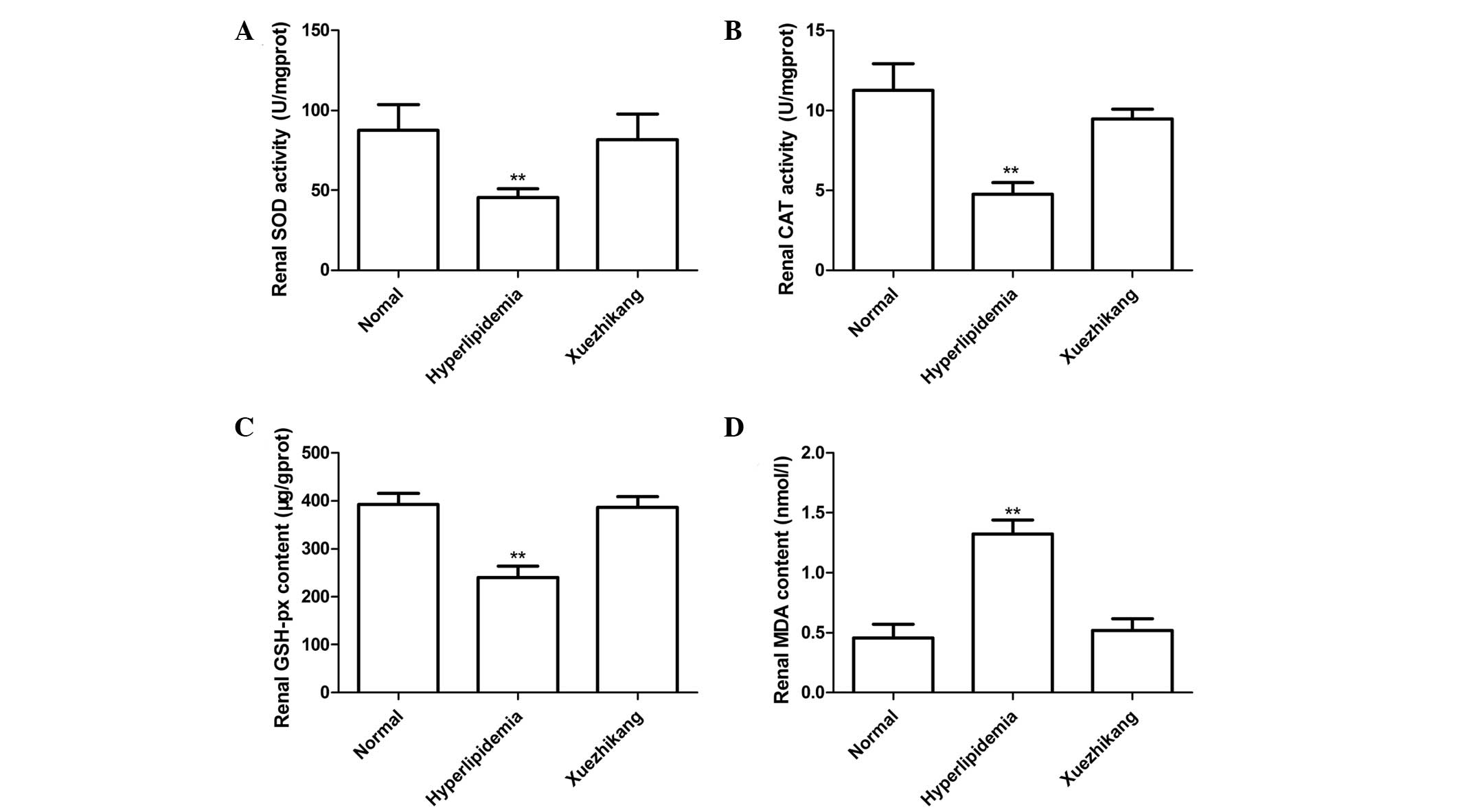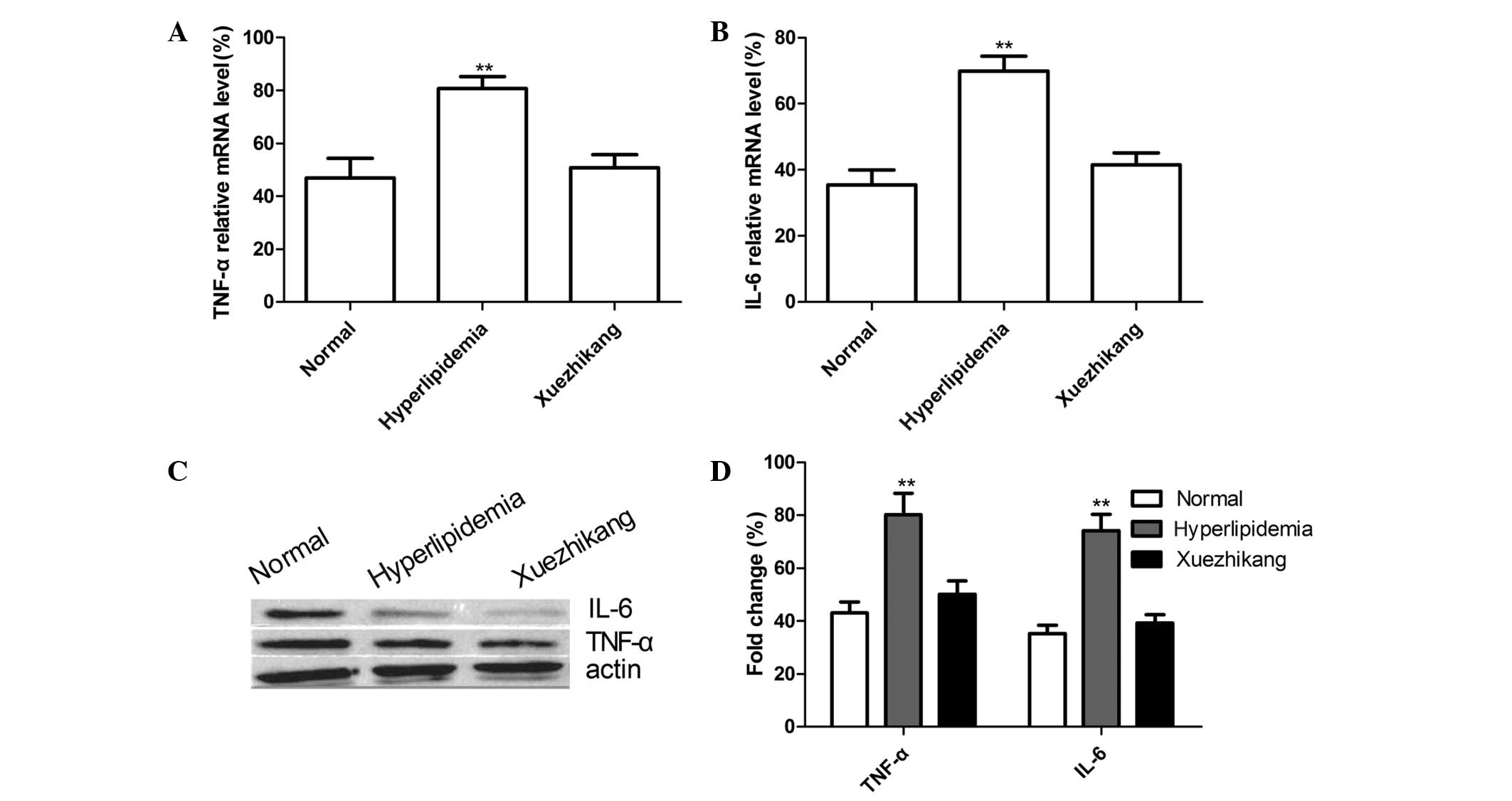|
1
|
Suk HY, Zhou C, Yang TT, et al: Ablation
of calcineurin Aβ reveals hyperlipidemia and signaling cross-talks
with phosphodiesterases. J Biol Chem. 288:3477–3488. 2013.
|
|
2
|
Pöss J, Custodis F, Werner C, Weingärtner
O, Böhm M and Laufs U: Cardiovascular disease and dyslipidemia:
beyond LDL. Curr Pharm Des. 17:861–870. 2011.PubMed/NCBI
|
|
3
|
Vaziri ND and Norris K: Lipid disorders
and their relevance to outcomes in chronic kidney disease. Blood
Purif. 31:189–196. 2011. View Article : Google Scholar : PubMed/NCBI
|
|
4
|
Burst V and Benzing T: Dyslipidemia
treatment and cardiovascular disease in the renal patient. Curr
Pharm Des. 17:894–907. 2011. View Article : Google Scholar : PubMed/NCBI
|
|
5
|
Lu ZL, Xu ZM, Kou WR and Zhao SP: Advance
in basic and clinical research of Xuezhikang capsule. Chin J Integr
Med. 12:85–93. 2006. View Article : Google Scholar : PubMed/NCBI
|
|
6
|
Prospective Studies Collaboration.
Lewington S, Whitlock G, Clarke R, et al: Blood cholesterol and
vascular mortality by age, sex, and blood pressure: a meta-analysis
of individual data from 61 prospective studies with 55,000 vascular
deaths. Lancet. 370:1829–1839. 2007. View Article : Google Scholar : PubMed/NCBI
|
|
7
|
Shang Q, Liu Z, Chen K, Xu H and Liu J: A
systematic review of Xuezhikang, an extract from red yeast rice,
for coronary heart disease complicated by dyslipidemia. Evid Based
Complement Alternat Med. 2012:6365472012.PubMed/NCBI
|
|
8
|
Ma J, Li Y, Ye Q, et al: Constituents of
red yeast rice, a traditional Chinese food and medicine. J Agric
Food Chem. 48:5220–5225. 2000. View Article : Google Scholar : PubMed/NCBI
|
|
9
|
Zhu XY, Li P, Yang YB and Liu ML:
Xuezhikang, extract of red yeast rice, improved abnormal
hemorheology, suppressed caveolin-1 and increased eNOS expression
in atherosclerotic rats. PLoS One. 8:e627312013. View Article : Google Scholar : PubMed/NCBI
|
|
10
|
Journoud M and Jones PJ: Red yeast rice: a
new hypolipidemic drug. Life Sci. 74:2675–2683. 2004. View Article : Google Scholar : PubMed/NCBI
|
|
11
|
Liu J, Zhang J, Shi Y, Grimsgaard S,
Alraek T and Fønnebø V: Chinese red yeast rice (Monascus
purpureus) for primary hyperlipidemia: a meta-analysis of
randomized controlled trials. Chin Med. 1:42006. View Article : Google Scholar
|
|
12
|
Lu Z, Kou W, Du B, et al; Chinese Coronary
Secondary Prevention Study Group. Effect of Xuezhikang, an extract
from red yeast Chinese rice, on coronary events in a Chinese
population with previous myocardial infarction. Am J Cardiol.
101:1689–1693. 2008. View Article : Google Scholar : PubMed/NCBI
|
|
13
|
Hong XZ, Li LD and Wu LM: Effects of
fenofibrate and xuezhikang on high-fat diet-induced non-alcoholic
fatty liver disease. Clin Exp Pharmacol Physiol. 34:27–35. 2007.
View Article : Google Scholar : PubMed/NCBI
|
|
14
|
Aebi H: Catalase in vitro. Methods
Enzymol. 105:121–126. 1984. View Article : Google Scholar
|
|
15
|
Paglia DE and Valentine WN: Studies on the
quantitative and qualitative characterization of erythrocyte
glutathione peroxidase. J Lab Clin Med. 70:158–169. 1967.PubMed/NCBI
|
|
16
|
Pan D, Zhang D, Wu J, et al: A novel
proteoglycan from Ganoderma lucidum fruiting bodies protects
kidney function and ameliorates diabetic nephropathy via its
antioxidant activity in C57BL/6 db/db mice. Food Chem Toxicol.
63:111–118. 2014.
|
|
17
|
Tietge UJ: Hyperlipidemia and
cardiovascular disease: inflammation, dyslipidemia, and
atherosclerosis. Curr Opin Lipidol. 25:94–95. 2014. View Article : Google Scholar : PubMed/NCBI
|
|
18
|
Martin SS, Blaha MJ, Blankstein R, et al:
Dyslipidemia, coronary artery calcium, and incident atherosclerotic
cardiovascular disease: implications for statin therapy from the
multi-ethnic study of atherosclerosis. Circulation. 129:77–86.
2014. View Article : Google Scholar
|
|
19
|
Schaeffner ES, Kurth T, Curhan GC, et al:
Cholesterol and the risk of renal dysfunction in apparently healthy
men. J Am Soc Nephrol. 14:2084–2091. 2003.PubMed/NCBI
|
|
20
|
Mänttäri M, Tiula E, Alikoski T and
Manninen V: Effects of hypertension and dyslipidemia on the decline
in renal function. Hypertension. 26:670–675. 1995.PubMed/NCBI
|
|
21
|
Takemura T, Yoshioka K, Aya N, et al:
Apolipoproteins and lipoprotein receptors in glomeruli in human
kidney diseases. Kidney Int. 43:918–927. 1993. View Article : Google Scholar : PubMed/NCBI
|
|
22
|
Abrass CK: Cellular lipid metabolism and
the role of lipids in progressive renal disease. Am J Nephrol.
24:46–53. 2004. View Article : Google Scholar : PubMed/NCBI
|
|
23
|
Tonelli M, Moyé L, Sacks FM, et al;
Cholesterol and Recurrent Events Trial Investigators. Effect of
pravastatin on loss of renal function in people with moderate
chronic renal insufficiency and cardiovascular disease. J Am Soc
Nephrol. 14:1605–1613. 2003. View Article : Google Scholar : PubMed/NCBI
|
|
24
|
Peev V, Nayer A and Contreras G:
Dyslipidemia, malnutrition, inflammation, cardiovascular disease
and mortality in chronic kidney disease. Curr Opin Lipidol.
25:54–60. 2014. View Article : Google Scholar : PubMed/NCBI
|
|
25
|
Shi Y, Guo R, Wang X, et al: The
regulation of alfalfa saponin extract on key genes involved in
hepatic cholesterol metabolism in hyperlipidemic rats. PLoS One.
9:e882822014. View Article : Google Scholar : PubMed/NCBI
|
|
26
|
Arafa HM: Curcumin attenuates diet-induced
hypercholesterolemia in rats. Med Sci Monit. 11:BR228–BR234.
2005.PubMed/NCBI
|
|
27
|
Martin SS, Blaha MJ, Blankstein R, et al:
Dyslipidemia, coronary artery calcium, and incident atherosclerotic
cardiovascular disease: implications for statin therapy from the
multi-ethnic study of atherosclerosis. Circulation. 129:77–86.
2014. View Article : Google Scholar
|
|
28
|
Tolman KG: The liver and lovastatin. Am J
Cardiol. 89:1374–1380. 2002. View Article : Google Scholar : PubMed/NCBI
|
|
29
|
Campese VM: Dyslipidemia and progression
of kidney disease: role of lipid-lowering drugs. Clin Exp Nephrol.
18:291–295. 2014. View Article : Google Scholar : PubMed/NCBI
|
|
30
|
Shang Q, Liu Z, Chen K, Xu H and Liu J: A
systematic review of xuezhikang, an extract from red yeast rice,
for coronary heart disease complicated by dyslipidemia. Evid Based
Complement Alternat Med. 2012:6365472012.PubMed/NCBI
|
|
31
|
Lin YC, Chiang CH, Chang LT, et al:
Simvastatin attenuates the additive effects of TNF-α and IL-18 on
the connexin 43 up-regulation and over-proliferation of cultured
aortic smooth muscle cells. Cytokine. 62:341–351. 2013.PubMed/NCBI
|
|
32
|
Li Z, Yang S, Lin H, et al: Probiotics and
antibodies to TNF inhibit inflammatory activity and improve
nonalcoholic fatty liver disease. Hepatology. 37:343–350. 2003.
View Article : Google Scholar : PubMed/NCBI
|
|
33
|
Libby P, Sukhova G, Lee RT and Galis ZS:
Cytokines regulate vascular functions related to stability of the
atherosclerotic plaque. J Cardiovasc Pharmacol. 25(Suppl 2):
S9–S12. 1995. View Article : Google Scholar : PubMed/NCBI
|
|
34
|
Ross R: The pathogenesis of
atherosclerosis: a perspective for the 1990s. Nature. 362:801–809.
1993. View
Article : Google Scholar : PubMed/NCBI
|
|
35
|
Van Zee KJ, Kohno T, Fischer E, Rock CS,
Moldawer LL and Lowry SF: Tumor necrosis factor soluble receptors
circulate during experimental and clinical inflammation and can
protect against excessive tumor necrosis factor alpha in vitro and
in vivo. Proc Natl Acad Sci USA. 89:4845–4849. 1992.
|
|
36
|
Fan XF, Deng YQ, Ye L, et al: Effect of
Xuezhikang Capsule on serum tumor necrosis factor-alpha and
interleukin-6 in patients with nonalcoholic fatty liver disease and
hyperlipidemia. Chin J Integr Med. 16:119–123. 2010. View Article : Google Scholar : PubMed/NCBI
|
















